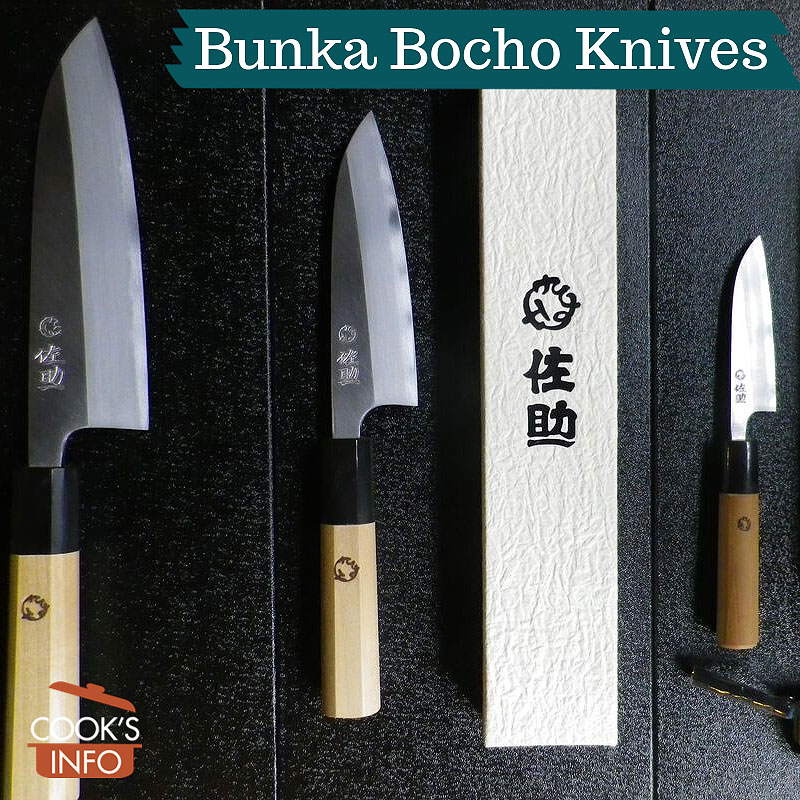
Bunka Bocho Knives. Sasuke / wikimedia / 2013 / CC BY-SA 3.0
A Bunka Bocho knife (文化包丁) is a Japanese all-purpose kitchen knife.
It has a pointed, somewhat triangular-shaped, blocky tip.
A bunka is not the best knife for rock-style chopping: “Since banno bunkas have fairly flat profiles they are most adept at push cutting and chopping rather than rock chopping.” [1]Bunka Knives. Madison, Wisconsin: Chef Knives to Go. Accessed October 2019 at https://www.chefknivestogo.com/bannobunkas.html
The blade
Compared to a Japanese Santoku knife, the blade of the Bunka is wider, and the pointed tip is blocky rather than curved. The tip is a reverse tanto one: that means it slopes outwards from the spine of the knife forward to the tip on the blade, rather than sloping downwards from the tip of the knife inwards to the blade. [2] “With its wider blade… The main difference between the Santoku and the Bunka Bocho lies in the shape of the blade tip, with the Bunka Bocho having a ‘reverse tanto’ tip / ‘clip point’, rather than a curved Kamagata (“Sickle-shaped”) tip”” — Bunka Knives. Seki-City, Gifu Prefecture, Japan: Kencrest Corporation. Accessed October 2019 at https://japanesechefsknife.com/collections/bunka
The shape of the tip makes it useful for cutting fish and meats. The heft of its moderate thickness helps in cutting meats, while still allowing the knife to be thin enough for fine vegetable work.
The length of Bunka knives will vary, but “165 mm (6.5 inch) and 180 mm (7.1 inch) lengths are … particularly popular.” [3]Bunka Knives. Seki-City, Gifu Prefecture, Japan: Kencrest Corporation. Accessed October 2019 at https://japanesechefsknife.com/collections/bunka Lengths up to 210 mm (8.3 inch) are also sold. [4]Tsubaki Blue #2 Bunka 210mm. Madison, Wisconsin: Chef Knives to Go. Accessed October 2018 at https://www.chefknivestogo.com/tsbl2bu21.html
Reviews
The Tokyo Knives website offers customers this guidance about bunka knives:
“This general purpose knife can manage many kitchen duties and is skilled at fine slicing shallots, celery, garlic, and herbs. The blade is medium sized and measures around five to eight inches. It makes it handy for use while carrying out scooping duties. The cutting edge features a double bevel and is ideal for chopping and push cutting. Rock chop is not possible because of the subtle curve. This knife is a bit thinner when compared to Santoku. It has a convex cross section which makes it ideal for use on vegetables and lean proteins. You can work on fish or meat efficiently because of dexterity offered by the blade. You can as well trim easily. As these knives are quite expensive, these are made in small batches by craft shops and independent smiths in Japan.” [5]The Ultimate Guide to Japanese Kitchen Knives. 11 July 2018. Accessed October 2019 at https://tokyoknives.com/blogs/news/the-ultimate-guide-to-japanese-kitchen-knives
History
The bunka knife started to appear in the late 1860s, after the Edo period laws against consuming four-legged animals were changed.
Language notes
“Bunka” means “culture.” “Bunka knive” literally means “cultural knife.” Many writers take that to mean the knife is designed to make traditional food at home.
That view, however, is disputed. Chris Lehrer, a Japanese knife enthusiast and frequent writer on the topic, points out that before Bunka knives appeared on the scene, the Edo rulers had imposed food purity laws on Japan. There was a specific knife in Japan for each purpose, and that you’d never, ever, mix knives used to cut flesh with those used to cut vegetables. In the mid 1800s, the “the Meiji Restoration” period, Westernization and modernization came to Japan. He writes:
“Bunkabocho means “cultural knife,” except that it doesn’t: in that period (Meiji-Taisho), bunka can mean “culture/al” but it can also mean modern, efficient, clever, chic, Western, etc. So here you’ve got a term that seems aimed at younger women and/or more urban ones. This knife isn’t the boring, stupid old nakiri that Grandma used, that’s for old people, not young, smart people like you. No, this knife is modern, up-to-date, and efficient! Buy one now! In either case, notice the notion of thrift and efficiency. The point is simple: instead of having multiple knives, you only need this one. Cut your meat and your vegetables with the same knife! Fish too, of course, though probably you’ll do that with a deba like your mother taught you — fish is too important to mess around with.” [6]Lehrer, Chris. Some basics on Japanese knife history. Cheftalk.com. 24 October 2009. Accessed October 2019 at https://cheftalk.com/threads/some-basics-on-japanese-knife-history-long.56934/
Videos
Sources
Bunka Knives. Seki-City, Gifu Prefecture, Japan: Kencrest Corporation. Accessed October 2019 at https://japanesechefsknife.com/collections/bunka
Elzinga, Ramon. The Bunka Knife or Bunka Bocho Knife. Woodville North, South Australia: Koi Knives. Accessed October 2018 at https://www.koiknives.com/blogs/japanese-knives/bunka-bocho-dicing-knife
Japanese Kitchen Knife Types And Styles. Accessed October 2019 at http://zknives.com/knives/kitchen/misc/usetype/all/index.shtml
References
| ↑1 | Bunka Knives. Madison, Wisconsin: Chef Knives to Go. Accessed October 2019 at https://www.chefknivestogo.com/bannobunkas.html |
|---|---|
| ↑2 | “With its wider blade… The main difference between the Santoku and the Bunka Bocho lies in the shape of the blade tip, with the Bunka Bocho having a ‘reverse tanto’ tip / ‘clip point’, rather than a curved Kamagata (“Sickle-shaped”) tip”” — Bunka Knives. Seki-City, Gifu Prefecture, Japan: Kencrest Corporation. Accessed October 2019 at https://japanesechefsknife.com/collections/bunka |
| ↑3 | Bunka Knives. Seki-City, Gifu Prefecture, Japan: Kencrest Corporation. Accessed October 2019 at https://japanesechefsknife.com/collections/bunka |
| ↑4 | Tsubaki Blue #2 Bunka 210mm. Madison, Wisconsin: Chef Knives to Go. Accessed October 2018 at https://www.chefknivestogo.com/tsbl2bu21.html |
| ↑5 | The Ultimate Guide to Japanese Kitchen Knives. 11 July 2018. Accessed October 2019 at https://tokyoknives.com/blogs/news/the-ultimate-guide-to-japanese-kitchen-knives |
| ↑6 | Lehrer, Chris. Some basics on Japanese knife history. Cheftalk.com. 24 October 2009. Accessed October 2019 at https://cheftalk.com/threads/some-basics-on-japanese-knife-history-long.56934/ |

